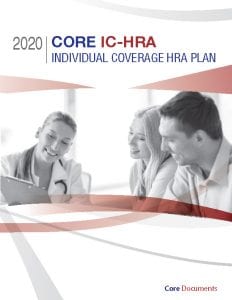Within the complex world of employee benefits, Health Reimbursement Arrangements (HRAs) are essential for improving access to healthcare. This blog seeks to explore the special benefits provided by Group Coverage HRA Plan Documents and to clarify the importance of HRA Plan Documents.
Understanding HRA Plan Documents:
The foundational documents that describe the terms, conditions, and advantages of health reimbursement arrangements are called HRA Plan Documents. Employees can use an HRA, a tax-advantaged benefit, to pay for qualified medical costs that aren’t covered by insurance. Employees can use this important benefit with clarity and transparency thanks to the guidance provided by the HRA Plan Document.

The Power of Group Coverage HRA Plan Documents:
Group Coverage HRA Plan Documents combine a team approach to further enhance the advantages of HRAs. Under a Group Coverage HRA, workers who belong to a specific organization or group collect money that the employer has set aside to pay for medical costs. In addition to promoting a feeling of community, this shared responsibility offers a more comprehensive and affordable coverage option.
Transparency and Empowerment:
Benefit offerings are made more transparent when HRA Plan Documents are implemented, particularly in a group setting. Workers are better equipped to make educated healthcare decisions when they are aware of the extent and constraints of their HRA benefits. This openness is essential for building employee satisfaction and trust, which enhances the work environment.
Tailored Solutions for Diverse Needs:
Group Coverage HRA Plan Documents offer flexibility, allowing employers to tailor healthcare benefits to the specific needs of their workforce. Whether it’s addressing chronic conditions, preventive care, or other health-related priorities, the customizable nature of Group Coverage HRAs ensures that employees receive benefits that align with their unique healthcare requirements.

Cost-Effective Healthcare Solutions:
Employers are frequently able to discover cost-effective methods to offer full healthcare coverage by combining resources into a Group Coverage HRA. Employees gain from this, and employers can more effectively control healthcare costs. Group Coverage HRAs’ collaborative structure encourages a sense of shared accountability that may enhance the patient experience and lower overall expenses.
Conclusion:
HRA Plan Documents provide an organized approach to healthcare accessibility in the constantly changing world of employee benefits, particularly when it comes to Group Coverage. Organizations can create a workforce that is not only healthier but also more engaged and satisfied by embracing these documents and effectively communicating their benefits. Employers can fully realize the potential of HRAs in promoting a culture of well-being and community in the workplace by emphasizing open communication and customizing healthcare solutions to meet the needs of a diverse workforce.
In this forever evolving work space, These HRA Plan document and group Hra Plan document definitely find a upper hand and give benefits to both employee and employer in maintaining a healthy work life ecosystem, If you want HRA Plan document and group HRA Plan Document for your company please visit coredocuments.com now, They have pdf available for both the plans, Consult them now.













